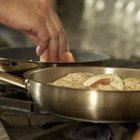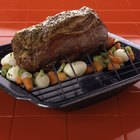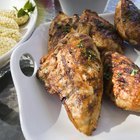
Whether you serve them as an appetizer or a main dish, cooked chicken wings are a real crowd pleaser. Hot or mild wings usually go quick -- which is a good thing, because like all cooked poultry products, they are perishable and should never remain at room temperature for extended periods of time. Storing the wings at temperatures below 40 degrees Fahrenheit, increases the amount of time that you can keep them before they spoil.
On the Serving Tray
Exposed to temperatures between 40 and 140 degrees Fahrenheit for prolonged periods of time exposes them to excessive bacterial growth that leads to foodborne illness. At temperatures of 40 F and higher, cooked chicken wings only remain edible for up to 2 hours before bacteria levels become dangerous. Out on a serving tray in the summer sun, with temperatures topping 90 F and above, the cooked chicken wings only remain edible for an hour.
In the Refrigerator
Refrigerated within two hours in temperatures of 40 degrees F and above and within an hour at temperatures of 90 degrees F and above, cooked chicken wings keep for up to four days. Although refrigeration does not kill any bacteria growing on the cooked chicken wings, it does slow bacterial growth over the four day period, keeping it safe to eat. After four days, bacterial growth increases and the chicken wings need to be discarded.
In the Freezer
Freezing cooked chicken wings keeps them safe to eat for an indefinite amount of time. Like refrigeration, freezing does not kill bacteria. However, the temperatures of zero F and below inside the freezer, do stunt bacterial growth, preventing any bacteria on the meat from multiplying. Once frozen, the cooked chicken wings keep for up to six months before deterioration sets in. Although this deterioration is not dangerous, it tends to affect taste and texture.
Precautions
Never thaw frozen, previously-cooked chicken wings out on the counter. The safest place to thaw is in the refrigerator -- transferring the chicken from freezer to refrigerator the night before you plan to eat it. Thawing in the microwave is a quicker method, but requires you to continue heating until the internal temperature of the wings reach 165 F, eliminating the risk of foodborne illness. Insert a meat thermometer into the chicken to test the internal temperature.
Related Articles

How Long Can Cooked Chicken Be ...

How to Defrost a Chicken in a ...

Does Caviar Go Bad?

Can I Cook Chicken That's Been Thawed ...

How to Bake Frozen Spanakopita

Do You Need to Defrost Chicken Wings ...

How Long Is Cooked Chicken Good?

How Long Can Guacamole Sit Out Before ...

How to Re-Crisp a Cold Roast Chicken

How Long Does a Pot Roast Last After It ...

How Long Can I Keep Frozen Whole ...

How Long Can a Bagel With Cream Cheese ...

How Fast Does Cooked Spaghetti Squash ...

How to Keep Tomatoes Fresh
How Long Does Cooked Lobster Stay Fresh?

Does Cornstarch Make Fried Chicken ...

How to Freeze Chunks of Butternut Squash
Can You Cook Chicken Wings the Day ...

Can I Cook a Chicken Five Days After ...

How Long Can Tuna Stay Fresh?
References
Writer Bio
Jonae Fredericks started writing in 2007. She also has a background as a licensed cosmetologist and certified skin-care specialist. Jonae Fredericks is a certified paraeducator, presently working in the public education system.
Photo Credits
Jupiterimages/Photos.com/Getty Images